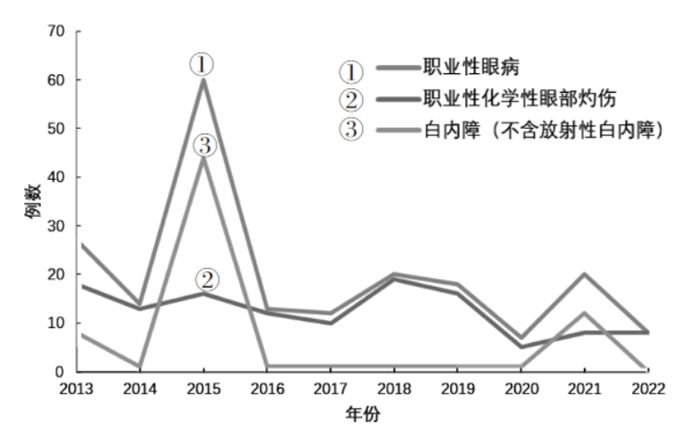Characteristics of diagnosed cases with occupational eye diseases in Jiangsu Province from 2013 to 2022
-
+ English摘要:目的 了解江苏省职业性眼病病例的分布特点,对存在的问题探讨原因并提出对策。方法 收集2013—2022年中国疾病预防控制中心职业病报告系统中江苏省职业性眼病诊断病例,建立数据库,并对数据进行统计分析。结果 2013—2022年全省职业病诊断机构共诊断职业性眼病199例,其中职业性化学性眼灼伤125例,占62.81%;职业性白内障70例,占35.18%;电光性眼炎4例,占2.01%。职业性眼病病例诊断时平均年龄(49.69±15.47)岁,接害工龄中位数为5(1.00,15.00)年。男性占94.47%,女性占5.53%,男女比例17.09∶1。职业性化学性眼灼伤致病因素主要为氢氧化钠、氟化氢、氯化氢和盐酸,分别占41.60%、16.80%、12.00%。行业分布以制造业为主,占85.93%,其中以纺织及印染加工业、金属制品业、化学原料和化学制品制造业、炸药及火工产品制造、设备制造业为主。江苏省13个地市中的12个地市有职业性眼病病例,主要分布在无锡、南京、徐州等地。企业分布以中小型私有经济类型企业为主。结论 江苏省职业性眼病诊断数量总体平稳,偶有群发,且有行业地区集中性。应根据职业性眼病的发病特点,结合不同行业地区的情况,加强职业健康宣教及监管,减少职业性眼病的发生。
-
职业性眼病包括职业性化学性眼灼伤、电光性眼炎和职业性白内障。职业性眼病每年报告人数在职业病总报告人数中占比不多,在2021年全国职业病报告的各类职业病中仅排第八位[1],但持续存在。为全面掌握近年江苏省内职业性眼病发病情况,本研究针对2013—2022年江苏省职业性眼病病例特征进行分析,以期为职业性眼病的防控提供参考依据。
1. 对象与方法
1.1 对象
收集2013年1月1日—2022年12月31日中国疾病预防控制信息系统职业病报告卡中江苏省职业性眼病病例作为研究对象。所有病例均由江苏省有职业病诊断资质的机构依据中华人民共和国职业性眼病相关诊断标准进行诊断并审核上报。
1.2 方法
1.2.1 研究方法
收集病例的基本信息、工龄、病种、所在行业和地区、所在企业的规模和经济类型等资料进行分析。其中行业按照GB/T 4754—2017《国民经济行业分类》 [2]进行分类,经济类型按照《关于划分企业登记注册类型的规定调整的通知》(国统字〔2011〕86号)[3]进行分类,企业规模按照《国家统计局关于印发统计上大中小微型企业划分办法的通知》(国统字〔2017〕213号)[4]要求进行分类。
1.2.2 统计学分析
采用Excel 2021软件对数据进行整理汇总,SPSS 23.0软件进行统计学分析。符合正态分布的数据采用均数±标准差(x ± s)表示,不符合正态分布采用中位数和四分位数间距[M(P25,P75)]表示,计数资料用频数和构成比表示。
2. 结果
2.1 基本情况
2013—2022年全省职业病诊断机构共诊断职业性眼病199例,其中职业性化学性眼灼伤125例,占62.81%;职业性白内障70例,占35.18%;电光性眼炎4例,占2.01%;未诊断出职业性放射性白内障病例。
从10年的发病情况来看,2015年因集体诊断为职业性白内障,导致人数明显增多而出现峰值,其余年份职业性眼病诊断人数较平稳。2019年之前职业性化学性眼灼伤每年诊断10 ~ 20例,2020—2022年每年诊断人数低于10人,较之前有所减少。职业性白内障2015年诊断44例、2021年和2013年分别诊断12例和8例,2022年未诊断,其余每年仅诊断1例,偶有集体发病状态。电光性眼炎仅2013、2017、2019、2020年诊断4例,处于散发状态。见图 1。
2.2 人群分布情况
职业性眼病病例诊断时年龄为16 ~ 84岁,平均年龄(49.69 ± 15.47)岁。接害工龄1 d ~ 44年,中位数5(1.00, 15.00)年,有129名(68.8%)的诊断病例发病时接害工龄低于3年。男性188名,占94.47%,女性11名,占5.53%,男女比例17.09∶1。各病种人群分布情况见表 1。
表 1 2013—2022年江苏省职业性眼病人群分布职业性眼病 例数(占比/%) 平均年龄/岁 接害工龄/年 男 女 职业性化学性眼灼伤 119(95.20) 6(4.80) 50.87 ± 16.25 2(0.01,5.00) 职业性白内障 65(74.48) 5(25.52) 47.29 ± 13.66 19(13.00,30.00) 电光性眼炎 4(100) 0(0) 45.25 ± 20.37 7.5(1.50,9.00) 合计 188(94.47) 11(5.53) 49.69 ± 15.47 5(1.00,15.00) 2.3 职业病危害因素情况
各类职业性眼病致病的职业病危害因素不同。职业性化学性眼灼伤(125例)致病因素主要为氢氧化钠,有52例(占41.60%),氯化氢和盐酸15例(占12.00%),氟化氢21例(占16.80%),甲苯7例(占5.60%),氮氧化物5例(占4.00%),氨4例(占3.20%),铬及其化合物2例(占1.60%),百草枯1例(占0.80%)。
职业性白内障(70例)的致病因素主要为三硝基甲苯,有68例,占97.14%,不详2例(占2.86%)。电光性眼炎(4例)的致病因素均为电焊作业中接触的紫外辐射。
2.4 行业类型分布
病例所在行业以制造业为主,共171例,占85.93%。其中纺织及印染加工业39例,占19.60%;金属制品业30例,占15.08%;化学原料和化学制品制造业29例,占14.57%;炸药、火工产品制造26例,占13.07%;设备制造业24例,占12.07%。其次是服务行业,17例,占8.54%。
化学性眼灼伤主要分布在纺织及印染加工业、化学原料和化学制品制造业、金属制品业,分别占26.40%、16.00%、14.40%。职业性白内障主要分布在设备制造业、炸药、火工产品制造及医药制造业,分别占24.29%、22.86%、17.14%。电光性眼炎1例分布在化学原料和化学制品制造业、1例在纺织及印染加工业,2例在服务行业。见表 2。
表 2 2013—2022年江苏省职业性眼病病例行业分布[例数(占比/%)] 行业 职业性化学性眼灼伤物 职业性白内障 电光性眼炎 总计 制造业 农副食品加工、食品制造 4(3.20) 1(1.43) 0(0) 5(2.51) 纺织及印染加工、制鞋业 33(26.40) 5(7.14) 1(25.00) 39(19.60) 石油、煤炭及其他燃料加工业 4(3.20) 1(1.43) 0(0) 5(2.51) 化学原料和化学制品制造业 20(16.00) 8(11.43) 1(25.00) 29(14.57) 医药制造业 2(1.60) 2(2.86) 0(0) 4(2.01) 金属制品业 18(14.40) 12(17.14) 0(0) 30(15.08) 设备制造业 7(5.60) 17(24.29) 0(0) 24(12.06) 炸药、火工产品制造 10(8.00) 16(22.86) 0(0) 26(12.07) 电气机械和器材制造业 7(5.60) 2(2.86) 0(0) 9(4.52) 服务行业 12(9.60) 3(4.29) 2(50.00) 17(8.54) 火力发电 2(4.60) 1(1.43) 0(0) 3(1.51) 建筑业 1(8.00) 1(1.43) 0(0) 2(1.01) 交通运输、仓储和邮政业 5(4.00) 1(1.43) 0(0) 6(3.02) 合计 125(100) 70(100) 4(100) 199(100) 2.5 地区分布
江苏省13个地市中有12个地市报告了职业性眼病病例:无锡106例,占53.27%;南京37例,占18.59%;徐州28例,占14.07%;其余依次为:盐城市7例,占3.52%;镇江市5例,占2.51%;苏州市4例,占2.01%;南通、常州市均为2例,各占1.01%;泰州、淮安、扬州市均为1例,各占0.50%;连云港市没有诊断病例。具体见表 3。
表 3 2013—2022年江苏省职业性眼病病例地区、经济类型及企业规模分布[例数(占比/%)] 项目 职业性化学性眼灼伤 职业性白内障 电光性眼炎 总计 地区 南京市 29(23.30) 8(11.43) 1(25.00) 37(18.59) 苏州市 1(0.80) 3(4.29) 0(0) 4(2.01) 无锡市 73(58.40) 33(47.14) 2(50.00) 106(53.27) 徐州市 12(9.60) 16(22.86) 0(0) 28(14.07) 南通市 1(0.80) 1(1.43) 0(0) 2(1.01) 常州市 1(0.80) 1(1.43) 0(0) 2(1.01) 泰州市 1(0.80) 0(0) 0(0) 1(0.50) 盐城市 3(2.40) 0(0) 0(0) 7(3.52) 扬州市 0(0) 1(1.43) 0(0) 1(0.50) 淮安市 0(0) 1(1.43) 1(25.00) 1(0.50) 镇江市 4(3.20) 1(1.43) 0(0) 5(2.51) 连云港市 0(0) 0(0) 0(0) 0(0) 宿迁市 0(0) 1(1.43) 0(0) 1(0.50) 经济类型 国有经济 34(27.20) 10(14.29) 1(25.00) 44(22.11) 集体经济 2(1.60) 1(1.43) 0(0) 3(1.51) 私有经济 60(48.00) 39(55.71) 2(50.00) 99(49.75) 港澳台经济 16(12.80) 5(7.14) 0(0) 21(10.55) 外商经济 12(9.60) 12(17.14) 0(0) 24(12.06) 其他 1(0.80) 3(4.29) 1(25.00) 4(2.01) 企业规模 大 13(10.40) 8(11.43) 0(0) 21(10.55) 中 44(35.20) 22(31.43) 1(25.00) 66(33.17) 小 61(48.80) 38(54.29) 2(50.00) 99(49.75) 微 5(4.00) 0(0) 0(0) 5(2.51) 不详 2(1.60) 2(2.86) 1(25.00) 4(2.01) 合计 125(100) 70(100) 4(100) 199(100) 2.6 企业经济类型分布
职业性眼病病例在不同企业经济类型分布由多到少分别为:私有经济99例,占49.75%;国有经济44例,占22.11%;外商经济24例,占12.06%;港澳台经济21例,占10.55%;集体经济3例,占1.51%;4例企业经济类型不详。具体见表 3。
2.7 企业规模分布
职业性眼病病例在不同企业规模分布由多到少分别为:小型企业99例,占49.75%;中型企业66例,占33.17%;大型企业21例,占10.55%;微型企业5例,占2.51%;4例企业规模不详。具体见表 3。
3. 讨论
职业性眼病在职业病诊断总数中占比较少,10年来全国的诊断人数排名一直相对稳定[1, 5-11]。江苏省职业性眼病除在2015年因集体诊断出职业性白内障导致总数出现峰值外,其余时间基本上维持在每年20 ~ 50例,整体呈散发和集体群发共存的状态。分析原因可能是因为职业性眼病较其他职业病的发病率低、基数小,偶有集体诊断,人数即明显增多。另一方面,可能与用人单位和劳动者对职业性眼病了解不多,出现轻度职业相关眼病时未进行职业病诊断有关。
职业性化学性眼灼伤是最常见的职业性眼病,其职业病危害因素主要为氢氧化钠,与浙江省职业性化学性眼灼伤以氢氧化钠灼伤为主[12]一致。氢氧化钠是一种工业中常见的腐蚀性极强的强碱,广泛应用在造纸、合成化工、医药、印染、石油等各行业,氢氧化钠进入眼部能引起组织蛋白脱水坏死,导致视力下降、角膜穿孔,是职业性化学性眼灼伤最常见的职业病危害因素。由于工作时化学物质直接接触眼部,或意外事故所致眼部化学性损伤,极易造成眼睑、结膜、角膜等组织损害,严重时会引起角膜溃疡穿孔、继发性青光眼、眼斜视等并发症。眼灼伤发生时常伴随皮肤灼伤或急性中毒事故,且病情发展迅速,相关企业应在接触化学品的生产车间设置冲洗或洗眼装置,以便发生眼灼伤时能做到应急处置。统计发现68.8%的眼病病例发病时接害工龄低于3年,因此企业应在员工上岗前做好职业安全培训,工作时持续进行培训和监督管理。
职业性白内障主要职业病危害因素为三硝基甲苯。2013年集体诊断的病例主要为南京从事军工作业的部分人群。2015年、2021年的诊断病例主要来自一家从事炸药、火工等产品制造的民爆器材公司。经调查该民爆企业对职业病危害因素了解不清,企业安全生产及职业安全意识不强。主管部门应加强对生产和使用三硝基甲苯的用人单位的监管,促进其改进生产工艺,完善通排风设施及加强个体防护,降低工作场所空气中三硝基甲苯浓度,定期进行专业的职业健康体检。
江苏省职业性眼病主要分布在以纺织及印染加工、金属制品制造、化学原料和化学制品制造、炸药、火工产品制造为主的制造业,与上海市金山区职业性眼病发生行业[13]分布一致。职业性眼病的地区分布与行业的地区分布有关,如无锡市医药、化工等行业密集导致化学性眼灼伤发病较高,而民爆器材生产企业主要分布在徐州市,这是该地职业性白内障诊断较集中的原因。从企业类型和规模上看,职业性眼病主要分布在小型私有经济企业中,这类型企业本身占比较多,人员流动性大,企业不重视职业病危害因素防护,导致职业病发病较多。在对出现集体诊断的企业现场调查发现,企业和员工普遍对职业性眼病的认知不足,缺少相关的防护设施和应急预案。
职业性眼病的防控应当以预防为主。存在职业性眼病发生风险的企业,应提高安全生产意识,完善企业规章制度及操作流程,配备正确且足够的防护和应急设施设备,建立危化品管理制度及突发事件应急处理制度,对员工进行职业安全培训,并进行应急演练,减少职业性眼病的发生。
作者声明 本文无实际或潜在的利益冲突 -
表 1 2013—2022年江苏省职业性眼病人群分布
职业性眼病 例数(占比/%) 平均年龄/岁 接害工龄/年 男 女 职业性化学性眼灼伤 119(95.20) 6(4.80) 50.87 ± 16.25 2(0.01,5.00) 职业性白内障 65(74.48) 5(25.52) 47.29 ± 13.66 19(13.00,30.00) 电光性眼炎 4(100) 0(0) 45.25 ± 20.37 7.5(1.50,9.00) 合计 188(94.47) 11(5.53) 49.69 ± 15.47 5(1.00,15.00) 表 2 2013—2022年江苏省职业性眼病病例行业分布
[例数(占比/%)] 行业 职业性化学性眼灼伤物 职业性白内障 电光性眼炎 总计 制造业 农副食品加工、食品制造 4(3.20) 1(1.43) 0(0) 5(2.51) 纺织及印染加工、制鞋业 33(26.40) 5(7.14) 1(25.00) 39(19.60) 石油、煤炭及其他燃料加工业 4(3.20) 1(1.43) 0(0) 5(2.51) 化学原料和化学制品制造业 20(16.00) 8(11.43) 1(25.00) 29(14.57) 医药制造业 2(1.60) 2(2.86) 0(0) 4(2.01) 金属制品业 18(14.40) 12(17.14) 0(0) 30(15.08) 设备制造业 7(5.60) 17(24.29) 0(0) 24(12.06) 炸药、火工产品制造 10(8.00) 16(22.86) 0(0) 26(12.07) 电气机械和器材制造业 7(5.60) 2(2.86) 0(0) 9(4.52) 服务行业 12(9.60) 3(4.29) 2(50.00) 17(8.54) 火力发电 2(4.60) 1(1.43) 0(0) 3(1.51) 建筑业 1(8.00) 1(1.43) 0(0) 2(1.01) 交通运输、仓储和邮政业 5(4.00) 1(1.43) 0(0) 6(3.02) 合计 125(100) 70(100) 4(100) 199(100) 表 3 2013—2022年江苏省职业性眼病病例地区、经济类型及企业规模分布
[例数(占比/%)] 项目 职业性化学性眼灼伤 职业性白内障 电光性眼炎 总计 地区 南京市 29(23.30) 8(11.43) 1(25.00) 37(18.59) 苏州市 1(0.80) 3(4.29) 0(0) 4(2.01) 无锡市 73(58.40) 33(47.14) 2(50.00) 106(53.27) 徐州市 12(9.60) 16(22.86) 0(0) 28(14.07) 南通市 1(0.80) 1(1.43) 0(0) 2(1.01) 常州市 1(0.80) 1(1.43) 0(0) 2(1.01) 泰州市 1(0.80) 0(0) 0(0) 1(0.50) 盐城市 3(2.40) 0(0) 0(0) 7(3.52) 扬州市 0(0) 1(1.43) 0(0) 1(0.50) 淮安市 0(0) 1(1.43) 1(25.00) 1(0.50) 镇江市 4(3.20) 1(1.43) 0(0) 5(2.51) 连云港市 0(0) 0(0) 0(0) 0(0) 宿迁市 0(0) 1(1.43) 0(0) 1(0.50) 经济类型 国有经济 34(27.20) 10(14.29) 1(25.00) 44(22.11) 集体经济 2(1.60) 1(1.43) 0(0) 3(1.51) 私有经济 60(48.00) 39(55.71) 2(50.00) 99(49.75) 港澳台经济 16(12.80) 5(7.14) 0(0) 21(10.55) 外商经济 12(9.60) 12(17.14) 0(0) 24(12.06) 其他 1(0.80) 3(4.29) 1(25.00) 4(2.01) 企业规模 大 13(10.40) 8(11.43) 0(0) 21(10.55) 中 44(35.20) 22(31.43) 1(25.00) 66(33.17) 小 61(48.80) 38(54.29) 2(50.00) 99(49.75) 微 5(4.00) 0(0) 0(0) 5(2.51) 不详 2(1.60) 2(2.86) 1(25.00) 4(2.01) 合计 125(100) 70(100) 4(100) 199(100) -
[1] 国家卫生健康委员会. 国家卫生健康委发布2021年全国职业病报告[J]. 职业卫生与应急救援, 2022, 40(4): 416. https://www.cnki.com.cn/Article/CJFDTOTAL-ZYWS202204027.htm [2] 中华人民共和国国家质量监督检验检疫总局, 中国国家标准化管理委员会. 国民经济行业分类: GB/T 4754—2017[S]. 北京: 中国标准出版社, 2017. [3] 国家统计局, 国家工商总局. 关于划分企业登记注册类型的规定调整的通知: 国统字〔2011〕86号[A]. 2011-09-30. [4] 国家统计局. 国家统计局关于印发统计上大中小微型企业划分办法的通知: 国统字〔2011〕75号[A]. 2011-09-02. [5] 国家卫生和计划生育委员会. 2013年全国职业病报告[EB/OL]. (2014-06-30)[2023-06-10]. http://www.nhc.gov.cn/jkj/s5899t/201406/ed8ed220d0b74010bcb6dcd8e340f4fb.shtml. [6] 国家卫生和计划生育委员会. 2014年全国职业病报告[A]. 2015-12-08. [7] 国家卫生和计划生育委员会. 2015—2016年全国职业病报告[A]. 2017-12-28. [8] 国家卫生健康委员会. 2017年全国职业病报告[A]. 2018-06-12. [9] 国家卫生健康委员会. 2018年全国职业病报告[A]. 2019-05-31. [10] 国家卫生健康委员会. 2019年全国职业病报告[A]. 2020-06-08. [11] 国家卫生健康委员会. 国家卫生健康委发布2020年全国职业病报告[J]. 职业卫生与应急救援, 2021, 39(4): 381. https://www.cnki.com.cn/Article/CJFDTOTAL-ZYWS202204027.htm [12] 边阳莆, 潘萍萍, 周彩玲, 等. 浙江省职业化学性眼烧伤职业病诊断情况分析[J]. 中华眼外伤职业眼病杂志, 2018, 40(11): 831-833. [13] 俞丹丹, 王丽华, 王莉萍, 等. 2004—2014年上海市金山区职业性眼病流行病学特征[J]. 环境与职业医学, 2015, 32(11): 1047-1050. https://www.cnki.com.cn/Article/CJFDTOTAL-LDYX201511016.htm






 下载:
下载:
